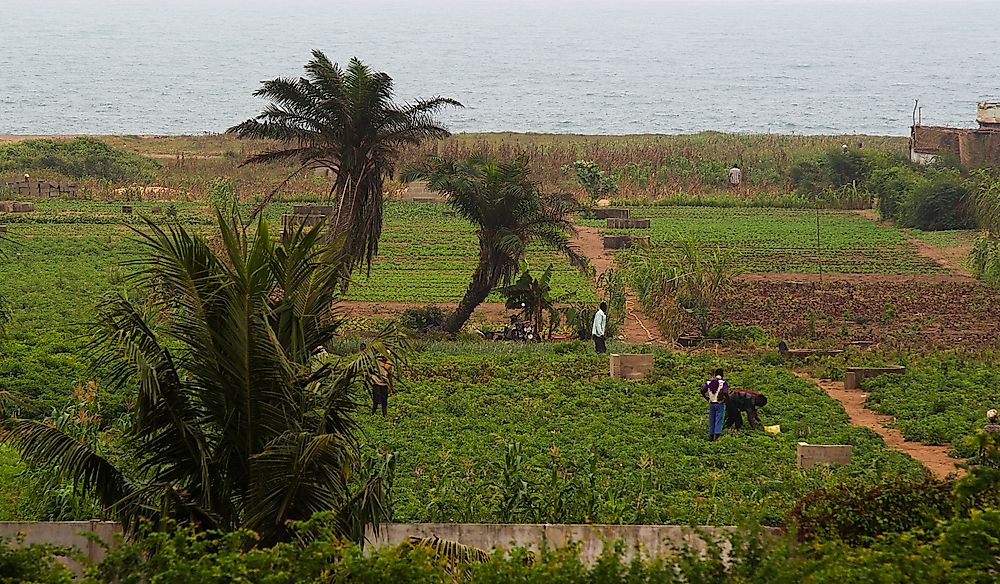What Are The Biggest Industries In Togo?

The West African nation of Togo covers an area of 22,008 square miles making it one of Africa's smallest countries. Lome, the capital city, is located on the Gulf of Guinea. The country also has a coastline on the Atlantic Ocean. The population of Togo, according to the estimates of 2017, was about 7.9 million people. Togo is one of the poorest countries in the world. The country's economy has been greatly affected by political instability which has undermined development for a long time. In 2017, the country received a credit facility of $238 million from the IMF. In 2017, Togo had a GDP of $4.76 billion while in 2016 it was $4.39 billion. The country relies heavily on agriculture, which accounts for a huge proportion of the country's exports.
Agriculture
Agriculture is critical to the economy of Togo, although it has been struggling because of the severe shortage of funds to acquire irrigation equipment and other inputs like fertilizers, which has severely curtailed the production of agriculture. In 2012, agriculture accounted for 28.2% of the GDP and employed about 49% of the labor force in Togo. The country is self-sufficient in the production of food, and livestock rearing is predominantly cattle breeding.
Most of the country's population relies on subsistence agriculture, and some of the country's agricultural output includes cocoa, coffee, corn, rice, cassava, yams, cotton, beans, millet, and sorghum. Cash crop and food production employs most of the country's labor force and accounts for about 42% of the GDP. The primary cash crops in the country are coffee and cocoa, which has traditionally been the main export item from the country. In the recent past, they have increasingly become one of the essential crops in the country, and by 1999 it was producing 173,000 tons; however in 2001 production fell significantly to 113,000 metric tons, but it rebounded back in 2002 to produce 168,000 metric tons.
Although the country does not receive sufficient rainfall in most parts of the country, Togo has attained self-sufficiency in food items such as cassava, corn, groundnuts, millet, and sorghum. Small and medium-sized firms in the country are the largest producers of food crops, which average about 1 to 3 hectares in size.
Mining
Mining is an important industry in Togo, and in 2012 the industry generated 33.9% of the nation's GDP, while in 2010, it employed about 12% of the total population.
Togo has the world’s fourth-largest phosphate deposits estimated at more than 60 million metric tons, and the country has been producing about 2.1 million tons of phosphate annually, although there has been a decline since the 1990s. In the mid-1970s prices of phosphates increased fourfold, resulting in a huge increase in government revenues. Mining phosphate has been facing numerous challenges as a result of the falling prices of the commodity in the world market as well as stiff competition from foreign countries.
Togo also has significant deposits of other minerals such as salt, marble, and limestone. Because of the large deposits of limestone in the country, Togo can produce cement. Other minerals mined in Togo include gold, diamonds, and limestone. Other minerals which have been discovered in the country but they are not extracted include bauxite, manganese, iron ore gypsum, rutile, marble, and zinc.
Manufacturing
The manufacturing industry in Togo accounts for a small portion of the country's economy and contribute for about 6 to 8% of the total economy. The major manufacturing sectors in the country include processing of agricultural products such as cotton, weaving and ginning, coffee roasting, extraction of palm oil, and manufacture of textiles. Other industries in the country provide consumer goods such as footwear, confectionery, tires, and salt.
Most industries in Togo were owned by the government until the mid-1980s when liberalization of in the economy was undertaken and by 1990 almost half of the parastatals in the country had been sold or leased. By 2002, most privatization in the country had stopped. In the 1970s and 1980s government invested heavily in industrial schemes such as the cement plant, oil refinery plant, steelworks, and phosphoric acid plant. However, most of these factories have closed down.
The government also established numerous industrial free zones to encourage investment from abroad, such as free trade zone in Lome which opened in 1990. The political instability in the country has affected industrial development and even foreign investment in the country.
The government's national development plan for 2018-2022, the government is planning to establish a manufacturing hub and two major industrial parks with each having 15 intensive factories to produce items such as shoes and textiles ideally for the export market. The government hopes to boost the country's textile export to the different foreign markets such as the United States where the country has been granted AGOA privileges. The government hopes to boost local know-how, production of cotton, and improve searching of strategic partners. The project is anticipated to create more than 100,000 jobs, and the government is planning to create value chain of different sub-sectors, and as a result, it is anticipated that the annual growth of the industrial and manufacturing industry to average about 10%.
Challenges
Property in Togo is still one of the greatest challenges in the country although poverty rates dropped from 61.7% to 55.1% between 2006 and 2015, and by 2017 it stood at 47.4%. Poverty in the country is widespread, particularly in the rural areas where in 2015, about 69% of households lived below the poverty line. In 2015, Togo had made some progress only on six out of the eight Millennium Development Goals. Some of the major challenges of development in Togo include developing industries with strong growth potential such as strengthening economic infrastructure, agribusiness, strengthening basic social services such as water, health, and power. Other challenges include financial inclusion, social environmental protection, gender equity in health, promoting sustainable development, and more balanced participation.











